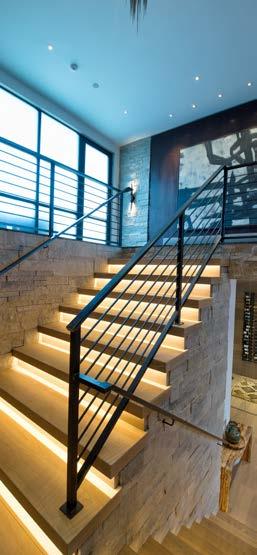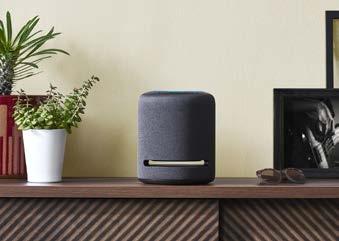
18 minute read
CEDIA Awards
THE CEDIA AWARDS: MORE THAN A TROPHY
For Nic Black, managing director of the UK’s Pyramid Group, winning a CEDIA Award means quite a bit more than a pretty piece of hardware — for Black and his firm, it means more highend business.
“When we won our first Home Cinema Level II, which was in 2016, that project was something that obviously we marketed quite heavily as a result,” Black remembers. “And within five weeks of that project being awarded, we had a conversation with a gentleman from Ireland. I inquired how he heard of us, and he said, ‘Well, simply, I wanted a cinema; the best I could get.’
“So he went to the CEDIA website,” says Black. “He saw that we had just been awarded for Level II. So, he said, ‘Well, you're clearly the best in the industry this year, so that's why I'm phoning you.’”
Awards = Credibility
For Jason Barth, a founder of The Premier Group in Indiana, US, his company’s two wins in the category of Best Integrated Home, Level IV (2018
and 2019, Americas), have provided a wealth of marketing opportunities. When CEDIA’s Director of Public Relations and Industry Relations Olivia Sellke fielded a call from the Wall Street Journal (a reporter was interested in doing a story on high-end media rooms for the Journal’s “Mansions” section), Premier was one of the firms that wound up making the final cut after Sellke had made a number of introductions to Award winners and finalists. This was the first of two stories picked up by the WSJ in 2019, and after working with CEDIA, six members were featured overall. “CEDIA Awards project winners and Members of Excellence are always our first go-to for any media opportunities — the submission process provides the key details that help us create a compelling hook for a story pitch and give us a great repository for when a member of the press has a specific request,” says Sellke.
That bit of press in the WSJ stands out for Barth for a number of reasons. First and foremost, as he says, “My stepdad reads the Wall Street Journal cover to cover every day, and I did not tell him that we were making the journal. I think it was about 10 after seven in the morning the day that issue came out, and my phone's already ringing. It's my mom, and she's like, ‘Oh my God, you're in the Wall Street Journal!’”
Parental pride aside, that project has been a great resource for Premier, and not just as a marketing tool for clients: “I met with a homeowner and her interior designer (who’d flown in from Minnesota), and the client and the designer were sitting at a table when I walked into the house. This house is in drywall and finish trim, and the client turns, looks at me, and says, ‘Hey, I heard you guys just won another award.’”
As Barth further notes, that kind of credibility from the homeowner puts design and build pros right at ease. Winning a CEDIA Award provides a wealth of marketing opportunities. CEDIA's new design forward website (cediaawards.org) showcases all award winners and finalists’ projects as well as the year’s Best New Product and Product Hall of Fame winners.





The Entry
Of course, a firm can’t win if they don’t enter. Black’s firm has tallied three first-place wins and a “Highly Commended” trophy, and he’s got the process down to a science. After gathering all the technical data and choosing the perfect photos, he then becomes something akin to the managing editor of the entry.
“I would vet, write, and direct other team members. So, for example, if there’s a portion to do with lighting, then one of my colleagues who’s in charge of the technical lighting design within the organization would typically put together that information. It’s authored by those who are kind of specialists.
“Similarly, my colleague, Simon, who’s our audio guru, of course will have done all of the calculations, the speaker placements, angles, everything. It obviously stands to reason that he’s going to knit together the pre-project technical design and bring together the actual calibration results and summarize that.”
And to wrap up the process, Black fills in the rest of the blanks: “So I become more of an editor at the end. I’ll write quite a bit of it in terms of the construction, the design, the concepts, the client input.”
Hidden Figures?

Owning an integration business can be lucrative, but could your profit figure be masking some major room for improvement in the performance and finances of your business?
What if an average-to-good profit could be turned into an amazing profit?
How to break down your profit number?
Most integrators we talk to have at least two or three different segments of the business that can easily be identified. These could be broken down by geographical areas, residential versus commercial, and so on.
Once you have identified the segments of your business, you need to ensure the regular financial reports that you look at to drive your business decisions are broken down into those segments.
How do you do this?
Your financial reports will only be useful to you once the data behind the reports is accurate and segmented properly. This is a three-step process:
1) First, you need to break down the account codes or categories in your accounting software to accurately reflect the different segments of your business, 2) Then, ensure that your regular bookkeeping records your income and expenses as per these categories, and, 3) Configure your financial reports to be meaningful to you.
Data + Structure = Information Information + Knowledge = Intelligence Intelligence + Experience = Insight
Without this insight, you may look at your overall profit for the year and think you are doing great. But what if one segment of the business is very profitable and masking the other underperforming segments? How much better could you have done knowing this information and taking action to address this?
About the Author
Luke Desmond is the CEO & Founder of Crisp Accountancy, a UK firm that helps smart home and AV businesses to increase their profits, master their finances, and make better financial decisions.
32 UV TO THE RESCUE

CEDIA COMMUNICATES A s an electrician and systems integrator over the last 40-plus years, I have seen some radical changes in technology and the systems that we install and integrate. While most reading this are intimately familiar with the changes that have had such a huge impact on our industry when it comes to the integrated custom entertainment and communication systems that we install, I’ll bet there is one area that you all may not be as familiar with. I am referring to the lighting technology used to make our food and home environment cleaner and safer. Using ultra-violet light to kill germs, mold, and bacteria has been part of the food service, processing, and handling industry for many years. I’ve worked for a number of smaller industrial and commercial clients doing electrical work, and one of those was a soft drink bottling plant. This company used huge amounts of liquid sugar and corn sweeteners that were stored in large stainless steel tanks. To ensure purity of the product, we installed high-output UV lighting systems in the tanks, since these lights killed any bacteria and prevented the growth of mold. In some cases UV lights were also used to disinfect tools and mixers to ensure nothing could contaminate any part of the system. The use of UV lighting attained a pure system without using harsh or toxic chemicals.
From Hospital to Home
Medical services also use UV lighting sources to ensure that implements are as sterile as possible. In a few of our customers’ homes, we’ve used UV light installed in the fresh air ducts to kill mold and bacteria and to control allergens. While limited in use, they were effective in homes for people with compromised immune systems.
These UV light sources came with a number of cautions and safety warnings. These were wide-spectrum, high light output UV sources that could cause vision problems when viewed directly. Over time with exposure, they can increase the risk of skin-related problems.
Today, research is being done using LED lamps and luminaires to target specific bacteria, molds, and allergens. The University of Strathclyde in Glasgow, Scotland, discovered that a specific blue-light wavelength of proper intensity could deactivate methicillinresistant Staphylococcus aureus (MRSA) and other strains of bacteria. They found that using LED blue-light sources between 400 to 420 nanometers was effective in killing not only MRSA but other strains of bacteria. In fact, 405 nanometers was the best for the elimination of MRSA.
This groundbreaking research could save hundreds, if not thousands of lives every year. Hospitals spend huge amounts of money and allocate massive resources in the effort to keep MRSA from infecting patients.
More Than MRSA
The University of Strathclyde has continued their research using blue spectrum LED lighting against other bacteria including listeria and E. coli. The University has licensed their patents to a number of companies who are manufacturing lamps and luminaires that are being used in hospitals and other locations to control bacteria and other unwanted contaminants. Additionally, researchers are exploring the use of blue spectrum and UV light in wound treatment and care.
For those of us in the residential world, this research becomes important because companies like Neu-Tech Energy Solutions and Kenall are making lamps that are direct replacements for standard LED lamps using off-the-shelf luminaries.
These companies are providing lamps for residential applications that require mold remediation and anti-bacterial uses. You could, for example, use a lamp that combines white lights combined with the blue lights to kill mold in a shower. If customers are aging or have compromised immune systems due to illness, injury, or chronic health problems, the installation of the proper combination of blue and white light sources could have a dramatic impact on the quality of life.

GAME ON!

There’s money in esports — for players and integrators
Ian Bryant Vice President of Technology Application and Workforce Initiatives, CEDIA
A teenager won $4.3 million (out of a $43 million prize pool) at the 2019 Fortnite World Cup. The champ took home the top prize out of 1,381 players, after 40 million players participated in qualifying events across the globe. Fortnite has over 200 million players worldwide according to the game’s creator, Epic, but Fortnite doesn’t even award the largest payout. League of Legends and Counter-Strike Award pools have been in the $60 million range, and Data 2 is at $172 million, according to esportsearnings.com. Esports prize money payouts have surpassed Wimbledon, The Indy 500, and The Masters.
Gaming has achieved a popularity that the creators of Pong could have only dreamt of. According to the Entertainment Software Association (ESA), a massive 64% of households own a device that they use to play video games. Of those, 41% are PCs, and 36% are dedicated gaming consoles. No less than 56% of the most frequent gamers play multiplayer games, and of those 42% play with friends and 19% with family. Consumers spent $36 billion on gaming in 2017, $4.7B of that going to hardware and $2.2B to accessories. The number one influential factor for video game purchases is the quality of the graphics. From serious gamers trying to grab the esports spotlight or casual gamers having fun with friends and family, all of this gaming is building the demand for a space in the home to play.
The business opportunities for a game room in the home have never been better.

To get the full experience of high-quality gaming, gamers need a highperformance console or PC, coupled with a super-fast, high-quality display and a pair of high-definition headphones or even immersive sound. People are even creating their own multiplayer gaming rooms for parties and friendly competitions. It doesn’t take long when scrolling through a site like houzz.com to find thousands of game room examples that are professionally installed and set up by integrators.
What else do you need to include in a rock-solid game room in the home? For the best experience, you need: • A robust, enterprise-grade network with a high-speed internet connection and solid wireless throughout • Fast, large, and high resolution displays capable of 4K resolution with a minimum 144Hz refresh rate • Immersive sound, either in the room or on your head, so you can hear every pin drop in the game

Can Lightning Strike Twice?

Steve May considers the launch of Dolby Atmos Music and asks, have we heard it all before?
Steve May
With immersive audio now dominating the movie scene, from sound mixing to cinema design, Dolby has once again turned its attention back to audio, launching Dolby Atmos Music — but will this new immersive variant chart or tank?
In many ways, Dolby Atmos Music is a tip of the hat to the technology giant’s music heritage. OG AV pros will remember first encountering Dolby as an audio-only noise reduction technology. But Atmos Music is rather more sophisticated than Dolby A, B, or C. Adopting object-based content creation allows artists to strive for an entirely new listening experience, one seemingly ripe for technology integrators to exploit.
But there are caveats — and surround sound audio isn’t exactly new.
Super Audio CD and DVD-A didn’t just offer an early taste for highresolution audio on physical media, they also supported multichannel mixes. The SACD 5.1 release of Pink Floyd’s Dark Side of the Moon album remains to this day a powerful example of just how ahead of its time that Sony/ Philips disc format was, while Rush’s 2112, in multichannel DVD-Audio, still remains the next best thing to seeing the Canadian rockers live.


But sadly neither format took off. Dolby Atmos Music is taking a different approach. For one thing, it’s not dependent on any physical disc format. Sure, there are Dolby Atmos Music releases on Blu-ray, but they’re far from mainstream purchases. What actually makes this new Atmos iteration interesting are the partnerships Dolby has struck with streaming giants Amazon Music and Tidal.
Title availability may be limited, but, with both Universal and Warner on board, the catalog should improve rapidly.
Atmos is available as part of Amazon Music HD and on Tidal’s premium HiFi tier. But, frustratingly, the opportunities both offer are limited.
While Amazon’s Fire TV streamers (from the Fire TV Cube down) have an Amazon Music HD app, its device is limited to 24-bit stereo. You can’t output Atmos music from a Fire TV device over HDMI into a fully-fledged home theater system. Indeed, currently the only way to experience it is with the Amazon Echo Studio, a relatively inexpensive smart speaker, albeit one with a trio of mid-range drivers — one up-firing, one a downward-firing bass woofer, and one a tiny tweeter!
As a single device, the Echo Studio is undoubtedly interesting, but it hardly opens the door to new business.
Fellow Dolby Atmos Music supporter Tidal doesn’t even have the benefit of a media player platform. So just how are


users expected to enjoy this new era of immersive audio? On headphones, it seems.
But we have good news! A Dolby insider has confided to us that it is looking to unlock Dolby Atmos Music playback from Fire TV gizmos via a firmware update. So it might be worth designing listening rooms with Atmos in mind, sooner rather than later.
Of course, Dolby Atmos Music isn’t the only immersive music gig in town. Sony has a rival technology, known as 360 Reality Audio, which does much the same thing. Also available through Amazon Music, as well as Deezer, it’s similarly a headphone proposition, with decoding provided by a smartphone app. Thankfully, Sony hints at wider future use. Perhaps we’ll have 360 Reality Audio support on the upcoming PS5 games console?
Now that sounds like a plan to us. While immersive audio for music remains a work in progress, high-res audio has very much broken through. It’s now a tangible benefit, widely understood by consumers.
Qobuz, Deezer, Tidal, and Apple Music (under the Apple Digital Masters banner) have led the way, and the arrival of Amazon into the HD audio space is only going to accelerate customer demand. This translates to a solid opportunity to up-sell audio systems, and the spaces they live in.
That’s sweet music to everybody’s ears.
Highlights from our conversation with ETC’s Michael Cogbill
Cameras in Focus THE CEDIA PODCAST:
When it comes to surveillance and security — as with any other custom integration — the discovery process is key. Michael Cogbill, CEDIA Board Member and VP of engineering for ETC Simplify (Palm Beach, FL), is well-versed in these systems, from cameras to lenses to recorders to storage devices, and he joined a recent CEDIA podcast for a deep dive into all of these systems.
Cogbill stresses the critical nature of those initial discussions: “It’s interesting because we get these clients, and they come in and they start asking, ‘Well, what kind of cameras are you going to put in?’”
Cogbill’s response is consistent. “Whoa, wait a minute. If you had cameras, what would you do with them? “Here’s this starting point: What do you want to see? What is it that you think you want to see when you’re looking at your camera? Where do you want to put the emphasis? Are you wanting 100% coverage so you can see every inch of your property? Or do you just want to see the kids in the pool, and maybe see who’s coming up the driveway? Those are a lot different than if you’re doing a fairly high-security application.”
Want to hear the whole episode? It's "The CEDIA Podcast 1947: The Surveillance Show."

Better Than the Human Eye
Cogbill has a ton of examples to draw from — even marine applications.
“One of our clients had a really large yacht. It was berthed over in Perth, and he was taking it west across some very bad territory that had known pirates roaming those waters. In addition to having security, he wanted to have some visibility, particularly at night,” Cogbill remembers. The client had already determined that he’d need cameras with infrared capabilities. Cogbill had a better solution: “I told this gentleman, ‘You have to understand that you're out in the middle of the dark ocean, you're not going to see that well. You're only going to see a limited distance.’”
Other factors — fog, for example — made the infrared solutions less than ideal. “I convinced him to install what are called thermal cameras.” The client was impressed by the resolution they afforded — even at distances that could alert the crew to approaching danger in plenty of time. “We had these cameras that could see 1,500 to 2,000 feet out in total darkness,” notes Cogbill.
Pixels Per Foot, or PPF
For more common, land-based applications with traditional cameras, one of the many factors to consider is pixels-per-foot: That number has a pretty profound effect on resolution.
Cogbill explains: “If I take a picture of you from ten feet away with a 1080p camera, I’m going to get a pretty good image. If you are away from that camera — say 100 feet — fewer pixels are dedicated to your face. It’s going to be harder to figure out who’s in the shot.” That issue becomes compounded when the camera’s field of view is widened.
Cogbill notes that he has a baseline for PPF. “I try to design at 50 pixels per foot at my worst-case distance,” he explains. “At 25 pixels per foot, I'm probably not going to be able to see who it is. At 50 PPF, you can recognize someone. Say your client has a really deep backyard and a twomegapixel camera, and you open it up with 100-degree field of view, you’re going to miss some stuff.”
There’s much more info in the full podcast, but the bottom line here is that firms like Cogbill’s are seeing growth in the segment. Consumer awareness as a result of devices like DIY video doorbells are leading to interest in better products, says Cogbill. “I'm using more professionalgrade products that integrate well with our control systems.
“The whole integration game has changed with how we do this.”






